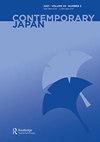Media representation of an imagined imperial community: Digital media reports in Japan at the dawn of the Reiwa era and Emperor Naruhito’s ascension to the throne
引用次数: 1
Abstract
ABSTRACT Drawing on media portrayals of the Japanese imperial family since the end of World War II, this study explores an imagined imperial community represented through Japanese digital media reports culminating at the dawn of Reiwa and Emperor Naruhito’s coronation in 2019. The study examines if the media representation of the Reiwa imagined imperial community reflects the preferred narrative of the Abe administration (2012–2020). The study’s main conceptual suppositions are Benedict Anderson’s imagined communities and Kurihara Akira’s performance model of the emperor system. Findings from a content analysis of digital media reports between 1 April 2019 and 4 May 2019 suggest that a) the Reiwa imagined imperial community was chiefly represented by media reports with nationalistic narratives in line with the Abe administration’s political philosophy, hinting at restoring a prewar imagined imperial community; and b) digital media organizations practiced sontaku – a media practice of willing submission to the government – by favoring the Abe administration’s narrative of the Reiwa imagined imperial community. Hence, the current study identified that the Reiwa imagined imperial community, which appeared in the digital media, was not just a high-profile historical event. Rather, the Reiwa imagined imperial community was a grand political performance scripted by the Abe administration with the media as the intermediary.一个想象中的帝国共同体的媒体表现:在令和时代和德仁天皇登基之初,日本的数字媒体报道
本研究以二战结束以来日本皇室的媒体形象为基础,通过日本数字媒体的报道,探索了一个想象中的帝国共同体,该共同体在2019年令和天皇和德仁天皇加冕之初达到顶峰。该研究考察了媒体对令和想象的帝国共同体的描述是否反映了安倍政府(2012-2020)的偏好叙事。本研究的主要概念假设是本尼迪克特·安德森的想象共同体和栗原明的天皇制度表现模型。对2019年4月1日至2019年5月4日数字媒体报道的内容分析结果表明,a)令和想象的帝国共同体主要由符合安倍政府政治哲学的民族主义叙事的媒体报道所代表,暗示恢复战前的想象帝国共同体;b)数字媒体组织通过支持安倍政府对令和想象中的帝国共同体的叙述,实践了sontaku——一种愿意服从政府的媒体实践。因此,目前的研究确定,在数字媒体上出现的令和想象的帝国共同体不仅仅是一个引人注目的历史事件。相反,令和认为,帝国共同体是安倍政府以媒体为中介编写的一场盛大的政治表演。
本文章由计算机程序翻译,如有差异,请以英文原文为准。
求助全文
约1分钟内获得全文
求助全文

 求助内容:
求助内容: 应助结果提醒方式:
应助结果提醒方式:


